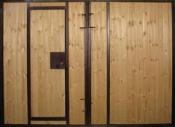Search
Login
Do-it-yourself septic tank from the rings on the infield
Landscaping and improving their country house, many people have to deal with the need to dispose of wastewater. This is quite natural, because can a house be considered comfortable and convenient if there is no plumbing and sewage system in it? So the owners of private real estate have to stock up on the knowledge and technology of the septic tank, where drains will be collected.
Content
- Advantages of a septic tank over other waste disposal systems
- Material calculation - how many rings do you need for a septic tank?
- Concrete rings for wells bonding rings video
- Planning and layout of a septic tank
- Preparation of a pit for a septic tank
- Installation of a septic tank from rings
- We build a septic shambo - construction rules theory and schemes / Septic system - circuit drawings video
Advantages of a septic tank over other waste disposal systems
Unlike cesspools and drainage pits, a septic tank does not require frequent visits of sewage machines emptying the contents and the arrival of such a car can only be caused by preventive measures.

- Rings for a septic tank are a relatively inexpensive building material, unlike biological wastewater treatment plants.
- The installation and installation technology is quite simple and even a person who does not understand the intricacies of construction work can cope with it.
- The service life of a septic tank can be more than 50 years! And this is not the limit.
Calculation of materials how many rings do you need for a septic tank?
As a rule, the sizes of the rings for the septic tank are standard and are 90 cm in height. For a standard septic tank, which does not have to be pumped out constantly, a depth of 3-4 meters will be quite enough and for this you will need 4-5 rings. The diameters of the rings vary greatly and can be from 70 cm to 2 meters in diameter.

For private construction, it is better to use medium ones with a diameter of 1 meter, which is enough for a volumetric septic tank. This ring weighs about 600 kg and you can install it yourself, with the use of lifting equipment. The only thing to remember before buying concrete rings is that at first the foundation pit digs under the septic tank, and only after that the rings are ordered directly. This will help the builder to save on attracting lifting mechanisms, because the car on which delivery is carried out is probably equipped with a crane for accurately removing the reinforced concrete products from the side of the machine.
Planning and layout of a septic tank
The scheme of a septic tank from rings is composed as follows:
- With a flow rate of up to one cubic meter of water, a septic tank from one well of a sump and one filter chamber will be quite enough.
- If the total water flow is from 1 to 10 cubic meters, then it is most reasonable to mount a septic tank by adding another settling chamber to its composition.
- With abundant consumption of moisture in the amount of more than 10 cubic meters, you will need a septic tank of 3 chambers and one filtration well.

After a preliminary calculation and determination of the volume, you need to determine the place of its placement. Some important tips for the location of the septic tank are given below:
- At least 5 meters must be retreated from the foundation of the house. This will help not only to get rid of the unpleasant odor, but also protect the foundation from washing out in case of emergency leakage of sewage.
- The septic tank should be at least 50 meters from the source of drinking water.
- It is highly advisable to arrange a septic tank on a small hill, this will help to avoid flooding with ground and melt water.
- The place for the septic tank is selected so that the sewer pipes are connected to it quite easily, without unnecessary angles and bends.

Preparation of a pit for a septic tank
After all the calculations are completed, and the layout of the septic tank is made of concrete rings, you can proceed directly to digging the pit.
In order to exclude products getting stuck in the ground during installation, it is necessary to dig a foundation pit with an allowance of 20-30 centimeters in diameter. That is, if the concrete ring has a diameter of 1 meter, then the diameter of the pit should be 1.20-1.30 meters. Depth depends on the selected volume of the septic tank and usually the soil from the recess is selected at 3-4 meters.
If the foundation pit digs under an overflow septic tank of concrete rings, then the question of whether the bottom needs to be concreted arises quite often. The fact is that sealing is needed only if the foundation pit is digging under the sump. Then the bottom is concreted or a reinforced concrete slab is laid on it. For filter chambers, bottom concreting is not required.
Installation of a septic tank from rings
After the foundation pit is prepared, you can proceed directly to assembling the septic tank from the rings with your own hands. For this, lifting equipment is required, since even a ring with a diameter of 70 cm weighs at least 400 kilograms and lowering it manually into the pit is incredibly difficult.
When using the crane, it must be ensured that it is equipped with soft slings that exclude the possibility of mechanical damage to the product, or with a spider that allows the ring to be lowered by special ears.

The rings are installed one at a time, strictly one on top of the other. Skews and shifts are unacceptable. After installation, the joints are concreted. After the cement has dried, it is necessary to go through the joints with a special mastic, which will prevent leakage and ensure the tightness of the chamber.

After installation and sealing, holes are made in the wells through which pipes will be supplied. The joints between the chamber and the sewer pipes are sealed as well as the joints.

That is, the gaps between the pipe and the chamber must be repaired with cements and put sealing mastic on top of it.
A concrete cover is installed over the well, and the space between the outer walls of the septic tank and the foundation pit is covered with soil. It is advisable to add a little clay to it, after drying it will provide the septic tank with additional tightness and protect it from accidental leakage.





